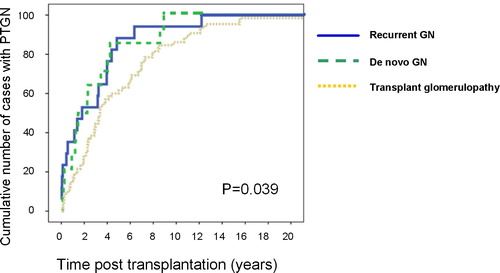Figures & data
Table 1 The demographic characteristics of the 2000 renal transplants.
Figure 1 Incidence of GN after transplantation. Post-transplantation incidence of recurrent GN (solid line) and de novo GN (dashed line) were significantly higher than transplant glomerulopathy (pointed line) (P = 0.039).

Table 2 Original kidney disease and immunosuppression of patients with PTGN.
Table 3 Medical complications after transplantation in patients with PTGN.
Figure 2 Graft survival of the recipients who did not develop PTGN vs recipients who developed PTGN. (A) Graft survival in the recipients who developed PTGN (dashed line) was comparable to those with no PTGN (solid line) in the first 2 years. Thereafter, there was a significant drop in graft survival in the group of recipients who had PTGN vs those who did not develop PTGN (P < 0.001). (B) Graft survival in the recipients who developed de novo GN (dashed line) and transplant glomerulopathy (pointed line) was comparable to those who did not develop PTGN (solid bold line) in the first 2 years (P = 0.067). While there was a significant drop in graft survival in recipients with recurrent GN (solid thin line) vs other groups in the first 2 years. Thereafter, there was a significant drop in graft survival in the group of recipients who had PTGN (whatever the type) vs those who did not develop PTGN (P = 0.001).

Figure 3 Patient survival of the recipients who did not develop GN vs recipients who developed PTGN. (A) Patient survival in the recipients who developed PTGN (dashed line) was comparable to those with no PTGN (solid line) in the first 5 years. Thereafter, there was a significant drop in patient survival in the group of recipients who had PTGN vs those who did not develop PTGN (P = 0.048). (B) patient survival in the recipients who developed PTGN (whatever the cause) was comparable to those who did not develop PTGN in the first 5 years. Thereafter, there was a significant drop in patient survival in the group of recipients who had de novo GN (dashed line) and transplant glomerulopathy (solid line) vs those who did not develop PTGN (P = 0.005).

